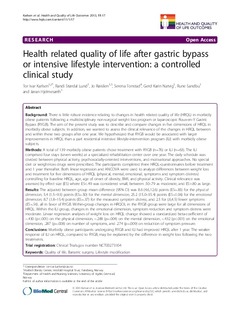| dc.contributor.author | Karlsen, Tor-Ivar | |
| dc.contributor.author | Lund, Randi Størdal | |
| dc.contributor.author | Røislien, Jo | |
| dc.contributor.author | Tonstad, Serena | |
| dc.contributor.author | Natvig, Gerd Karin | |
| dc.contributor.author | Sandbu, Rune | |
| dc.contributor.author | Hjelmeseth, Jøran | |
| dc.date.accessioned | 2013-05-02T08:15:35Z | |
| dc.date.available | 2013-05-02T08:15:35Z | |
| dc.date.issued | 2013 | |
| dc.identifier.citation | Karlsen, T. I., Lund, R. S., Røislien, J., Tonstad, S., Natvig, G. K., Sandbu, R., & Hjelmesæth, J. (2013). Health related quality of life after gastric bypass or intensive lifestyle intervention : controlled clinical study. Health and Quality of Life Outcomes, 11(February), 1-10. | no_NO |
| dc.identifier.issn | 1477-7525 | |
| dc.identifier.uri | http://hdl.handle.net/11250/138721 | |
| dc.description | Published version of an article in the journal: Health and Quality of Life Outcomes. Also available from the publisher at: http://dx.doi.org/10.1186/1477-7525-11-17 Open access | no_NO |
| dc.description.abstract | Background: There is little robust evidence relating to changes in health related quality of life (HRQL) in morbidly obese patients following a multidisciplinary non-surgical weight loss program or laparoscopic Roux-en-Y Gastric Bypass (RYGB). The aim of the present study was to describe and compare changes in five dimensions of HRQL in morbidly obese subjects. In addition, we wanted to assess the clinical relevance of the changes in HRQL between and within these two groups after one year. We hypothesized that RYGB would be associated with larger improvements in HRQL than a part residential intensive lifestyle-intervention program (ILI) with morbidly obese subjects.Methods: A total of 139 morbidly obese patients chose treatment with RYGB (n=76) or ILI (n=63). The ILI comprised four stays (seven weeks) at a specialized rehabilitation center over one year. The daily schedule was divided between physical activity, psychosocially-oriented interventions, and motivational approaches. No special diet or weight-loss drugs were prescribed. The participants completed three HRQL-questionnaires before treatment and 1 year thereafter. Both linear regression and ANCOVA were used to analyze differences between weight loss and treatment for five dimensions of HRQL (physical, mental, emotional, symptoms and symptom distress) controlling for baseline HRQL, age, age of onset of obesity, BMI, and physical activity. Clinical relevance was assessed by effect size (ES) where ES<.49 was considered small, between .50-.79 as moderate, and ES>.80 as large.Results: The adjusted between group mean difference (95% CI) was 8.6 (4.6,12.6) points (ES=.83) for the physical dimension, 5.4 (1.5-9.3) points (ES=.50) for the mental dimension, 25.2 (15.0-35.4) points (ES=1.06) for the emotional dimension, 8.7 (1.8-15.4) points (ES=.37) for the measured symptom distress, and 2.5 for (.6,4.5) fewer symptoms (ES=.56), all in favor of RYGB. Within-group changes in HRQOL in the RYGB group were large for all dimensions of HRQL. Within the ILI group, changes in the emotional dimension, symptom reduction and symptom distress were moderate. Linear regression analyses of weight loss on HRQL change showed a standardized beta-coefficient of -.430 (p<.001) on the physical dimension, -.288 (p=.004) on the mental dimension, -.432 (p<.001) on the emotional dimension, .287 (p=.008) on number of symptoms, and .274 (p=.009) on reduction of symptom pressure.Conclusions: Morbidly obese participants undergoing RYGB and ILI had improved HRQL after 1 year. The weaker response of ILI on HRQL, compared to RYGB, may be explained by the difference in weight loss following the two treatments. | no_NO |
| dc.language.iso | eng | no_NO |
| dc.publisher | BioMed Central | no_NO |
| dc.subject | quality of life | no_NO |
| dc.subject | bariatric surgery | no_NO |
| dc.subject | lifestyle modification | no_NO |
| dc.title | Health related quality of life after gastric bypass or intensive lifestyle intervention : controlled clinical study | no_NO |
| dc.type | Journal article | no_NO |
| dc.type | Peer reviewed | no_NO |
| dc.subject.nsi | VDP::Medical disciplines: 700::Health sciences: 800 | no_NO |
| dc.source.pagenumber | 1-10 | no_NO |
| dc.source.volume | 11 | no_NO |
| dc.source.journal | Health and Quality of Life Outcomes | no_NO |
| dc.identifier.doi | https://doi.org/10.1186/1477-7525-11-17 | |
